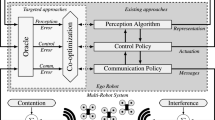Abstract
The physical layer(s) of wireless robotics take advantage of current standards, like Bluetooth, Wifi, etc., each of them addressing a specific segment of wireless robotics. Wireless robotics has a wide range of needs, comprising low power, robustness and high data rate when video is used as well as the opportunity to use a large number of transceivers. To cover these needs and take benefit from these opportunities, we propose a new physical layer, based on continuous phase modulation (CPM) and space-time coding. CPM, already used in some standards like GSM and Bluetooth, enables the development of low power devices, but presents a low spectral efficiency. Space-time coding on the other hand yields high spectral efficiency as well as enhanced robustness against the wireless channel. Moreover, space-time coding can take benefit of the large number of transceivers using cooperative communications. In this paper, after analysing the opportunities given by wireless robotics as well as its specific needs, we propose a new physical layer based on L 2-orthogonality for non-linear space-time codes. L 2-orthogonality of our codes is ensured by a bank of phase correction functions, maintaining phase continuity, but at the same time enabling low complexity decoding. We show that the code achieves full diversity and has full rate, for any number of transmit/receive antennas and any CPM parameter.
Similar content being viewed by others
References
Leonard, J., & Durrant-Whyte, H. (1991). Simultaneous map building and localization for an autonomous mobile robot. In International workshop on intelligent robots and systems (IROS), IEEE, Ed., Osaka, Japan. November, 19991 (Vol.~3, pp. 1442–1447).
Nosratinia A., Hunter T., Hedayat A. (2004) Cooperative communication in wireless networks. Communications Magazine, IEEE 42(10): 74–80
Jing Y., Hassibi B. (2006) Distributed space-time coding in wireless relay networks. IEEE Transactions on Wireless Communications 5(12): 3524–3536
Zhang, X., & Fitz, M. P. (2000). Space-time coding for Rayleigh fading channels in CPM system. In Proceedings of annual Allerton conference on communication, control, and computing.
Zhang X., Fitz M. P. (2003) Space-time code design with continuous phase modulation. IEEE Journal on Selected Areas in Communications 21: 783–792
Zajić, A., & Stüber, G. (2006). Optimization of coding gain for full-response CPM space-time codes. In Proceedings of IEEE global telecommunications conference (GLOBECOM ’06). November, 2006 (pp. 1–5).
Zajić, A., & Stüber, G. (2007). A space-time code design for partial-response CPM: Diversity order and coding gain. In Proceedings of IEEE international conference on communications (ICC’07). June, 2007 (pp. 719–724).
Maw, R. L., & Taylor, D. P. (2005). Externally encoded space-time coded systems with continuous phase frequency shift keying. In Proceedings of international conference on wireless networks, communications and mobile computing (pp. 1597–1602).
Wang G., Xia X.-G. (2004) An orthogonal space-time coded CPM system with fast decoding for two transmit antennas. IEEE Transactions on Information Theory 50(3): 486–493
Silvester A., Schober R., Lampe L. (2007) Burst-based orthogonal ST block coding for CPM. IEEE Transactions on Wireless Communications 6: 1208–1212
Silvester, A.-M., Lampe, L., & Schober, R. (2006). Diagonal block space-time code design for continuous-phase modulation. In Proceedings of IEEE global telecommunications conference. November, 2006 (pp. 1–6).
Hesse, M., Lebrun, J., & Deneire, L. (2011). L2-Orthogonal ST-code design for CPM. IEEE Transactions on Communications, 59(11), 3158–3166.
Anderson J., Aulin T., Sundberg C.-E. (1986) Digital phase modulation. Plenum Press, New York, NY
Hesse, M. (2011, April). L2-orthogonal space-time code design for continuous phase modulations. Ph.D. dissertation, University of Nice Sophia-Antipolis.
Tarokh V., Seshadri N., Calderbank A. R. (1998) Space-time codes for high data rate wireless communication: Performance criterion and code construction. IEEE Transactions on Information Theory 44(2): 744–765
Rimoldi B. (1988) A decomposition approach to CPM. IEEE Transactions on Information Theory 34: 260–270
Liang X.-B. (2003) Orthogonal designs with maximum rates. IEEE Transactions on Information Theory 49(10): 2468–2503
Author information
Authors and Affiliations
Corresponding author
Rights and permissions
About this article
Cite this article
Deneire, L., Lebrun, J. Continuous Phase Modulation and Space-Time Coding: A Candidate for Wireless Robotics. Wireless Pers Commun 64, 473–487 (2012). https://doi.org/10.1007/s11277-012-0597-3
Published:
Issue Date:
DOI: https://doi.org/10.1007/s11277-012-0597-3




